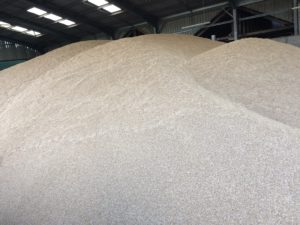Replacing Barley With Wheat In Intensive Diets
19 January 2018 In 2016 Simon Marsh at Harper Adams University investigated the use of wheat in intensive ad-lib finishing rations for bulls. In the trial half of the barley in the ration was replaced with wheat and all of the soya hulls used as a source of fibre, replaced with nutritionally improved straw (NIS). NIS is a commercial product produced by treating straw with sodium hydroxide. This strong alkali breaks down lignin cells, increasing its energy value and produces a very alkaline feed with a pH close to 9 which significantly reduces the risk of acidosis. There was a numerical improvement in performance with the wheat and NIS diet with an increase in DLWG (+0.08 kg), heavier slaughter weight (+8.5 kg) and earlier slaughter (6 days) however these differences were not statistically significantly different.
In 2016 Simon Marsh at Harper Adams University investigated the use of wheat in intensive ad-lib finishing rations for bulls. In the trial half of the barley in the ration was replaced with wheat and all of the soya hulls used as a source of fibre, replaced with nutritionally improved straw (NIS). NIS is a commercial product produced by treating straw with sodium hydroxide. This strong alkali breaks down lignin cells, increasing its energy value and produces a very alkaline feed with a pH close to 9 which significantly reduces the risk of acidosis. There was a numerical improvement in performance with the wheat and NIS diet with an increase in DLWG (+0.08 kg), heavier slaughter weight (+8.5 kg) and earlier slaughter (6 days) however these differences were not statistically significantly different.
The following year Simon investigated a 50:50 barley wheat ration with one containing 100% wheat. Both rations contained 10% NIS, soya, dark grains and mins/vits. Again there were no significant differences between the 2 rations but numerically the 100% wheat fed bulls recorded poorer performance as shown in the table below. Feed intakes for the wheat ration were lower which reduced feed costs per kg carcass gain from 199 to 192p/kg but due to the negative effect on bull performance . Over the 95 day finishing period this reduced margin over feed by £19 per head. These results mirror those found in a trial carried out in 2004 when barley was replaced with wheat for finishing British Blue x Holstein bulls and heifers.
Performance Of 50:50 Barley: Wheat With 100% Wheat In Intensive Finishing
| Treatment | Barley: Wheat | Wheat |
| Start weight (kg) | 328 | 329 |
| Slaughter weight (kg) | 584 | 577 |
| Days to slaughter | 192 | 195 |
| DLWG (kg/day) | 1.35 | 1.29 |
| Concentrate intake (kg/day) | 8.43 | 7.76 |
| FCR (kg feed/kg LWG) | 6.32 | 6.10 |
| Margin over feed (£/bull) | 800 | 781 |
This would suggest that if necessary wheat can fully replace barley in intensive rations providing the normal precautions are taken to avoid acidosis i.e. –
- Cereals are just cracked and not over processed .
- That clean long straw is always available through racks.
- Good feed hopper management to ensure feed is always available ad-lib.
The wheat/NIS ration was £1 per tonne higher in price based on the feed costs at the time of the study. A sensitivity analysis would show a financial benefit if wheat prices fall in relation to barley with on farm wheat available to feed. Including a highly alkaline feed such as NIS, will provide further protection against acidosis.
Basil Lowman, SAC Consulting Beef Specialist
Sign up to the FAS newsletter
Receive updates on news, events and publications from Scotland’s Farm Advisory Service
